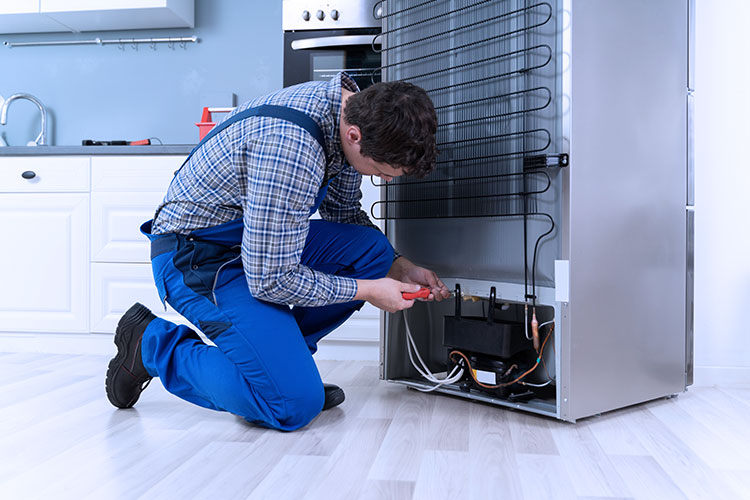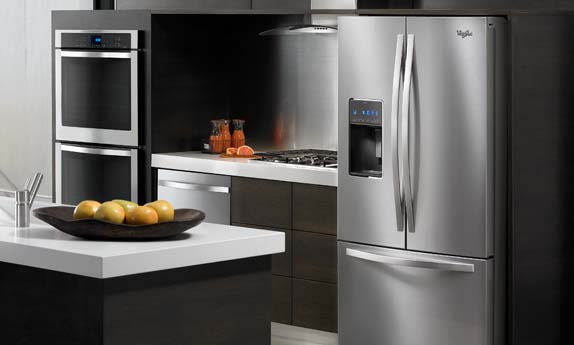Monthly Checkups from Subzero Repair Service Dependable Refrigeration & Appliance Repair Service Save You Thousands
Monthly Checkups from Subzero Repair Service Dependable Refrigeration & Appliance Repair Service Save You Thousands
Blog Article
The Ultimate Guide to Do It Yourself Home Appliance Repair Work Strategies
From refrigerators to dish washers, comprehending exactly how to troubleshoot and fix these devices can conserve you time and cash. Are you ready to find important techniques that will empower you to deal with fixings confidently?
Comprehending Usual Home Appliance Problems
When you count on your home devices, it can be annoying when they unexpectedly quit functioning or act up. Comprehending usual home appliance issues can assist you troubleshoot issues properly. If your fridge isn't cooling, inspect the temperature level settings or examine the door seal for gaps. A defective washing maker might be as a result of a clogged drainpipe filter or a busted belt.
If your oven isn't heating, defective aspects or thermostat problems might be to criticize,. Dishwashing machines usually experience troubles with drain, so ensure the filter is tidy and the drain hose pipe isn't kinked.
Additionally, listen for uncommon sounds; they typically show mechanical problems. By identifying these signs, you can conserve time and potentially prevent expensive repair services. A little expertise goes a lengthy means in maintaining your home appliances, so stay informed to maintain everything running smoothly.
Essential Tools for DIY Fixes
Before diving into do it yourself home appliance repairs, it's essential to gather the right devices to guarantee the process goes efficiently. Start with an excellent set of screwdrivers, consisting of both flathead and Phillips, as they're important for opening most devices. You'll likewise want a set of pliers for clutching and twisting wires or little elements.
Don't neglect a multimeter; it aids you examination electrical components and identify problems efficiently. A socket set comes in handy for loosening or tightening up screws, while an utility knife can be beneficial for reducing cables or opening up packaging.
Lastly, consider having a flashlight available to brighten dark rooms inside your devices. With these vital devices, you'll be fully equipped to tackle different fixings, saving both money and time. So, gather your gear and get all set to roll up your sleeves!
Security First: Precautions to Take
Prior to you begin any type of appliance fixing, it's necessary to prioritize security. Ensure you put on individual protective tools, detach the source of power, and keep your workplace organized. These easy safety measures can help prevent crashes and assure a smoother repair procedure.

Individual Safety Devices
Safety gear is a crucial part of any type of Do it yourself home appliance repair service project. Steel-toed boots are also a smart option, specifically when raising hefty home appliances. Remember, being prepared with the best gear keeps you safe and concentrated on completing your repair effectively.
Source Of Power Disconnection
To ensure a risk-free DIY appliance repair, separating the power source is important. Before you start any job, you should transform or disconnect the appliance off the circuit breaker. This easy action prevents electrical shocks and assurances that you can concentrate on the repair without bothering with unintended activation. Always confirm that the appliance is off by examining it with a voltage tester. If you're dealing with bigger appliances, like a washer or dryer, make certain to safeguard the power cord and prevent any contact with water. Remember, safety and security! As soon as you're positive that the power is separated, you can confidently continue with your repair work, recognizing you've taken the necessary preventative measures to shield yourself.
Workspace Organization
A well-organized job location can make all the distinction in your DIY device repair project. Beginning by clearing your work area of clutter to stop interruptions and crashes. A tidy area not just boosts performance yet also maintains you risk-free while you function on your appliance fixing.
Step-by-Step Overview for Fridge Repairs
When your refrigerator starts acting up, it can be frustrating, yet dealing with the problem yourself can conserve you time and money. Examine for usual issues like temperature changes or uncommon sounds. For a noisy refrigerator, examine the follower and verify it's not blocked.
If there's water merging inside, check the door seals for damage or dust, and clean them if required. When you have actually resolved the problem, connect the refrigerator back in and check it for a couple of hours.
Fixing Washing Equipment Concerns
Much like refrigerators, cleaning equipments can provide their very own collection of difficulties, yet lots of issues can be solved with a little bit of troubleshooting. If your device won't begin, examine the power cable and confirm it's connected in. Next, inspect the door latch; a defective lock can stop the cycle from starting. If you observe uncommon noises during procedure, it could be because of foreign items stuck in the drum or the drainpipe pump.
If your clothing aren't getting tidy, think about the water degree and detergent type; utilizing excessive detergent can produce excess suds, affecting performance. For leakages, examine the hoses for cracks or loose connections. Tightening up these can commonly fix the issue. Regular upkeep, like cleaning up the filter, can prevent lots of problems from emerging. Bear in mind, a little troubleshooting goes a long means in maintaining your cleaning device running efficiently.
Repairing Stoves and Cooktops
How can you troubleshoot common problems with your oven or stove? Begin by checking the power supply. Ensure it's connected in and the circuit breaker is not stumbled. Validate the gas valve is open if it's a gas oven. Next, test the heaters: if they do not stir up, cleanse the igniter and check for clogs in the burner ports.
If your oven isn't home heating, evaluate the temperature level setups and confirm the door seals snugly. If it's harmed., a faulty heating component could additionally be the offender; you might require to replace it.
For uneven cooking, rotate your pans and think about making use of an oven thermostat to confirm precise temperature levels. If you listen to uncommon noises or odor gas, transform off the appliance promptly and consult a professional. By following these steps, you can recognize and click for more settle lots of usual stove and stove concerns successfully.
Repairing Dishwashers Made Easy
When your dishwasher starts breaking down, it can be discouraging, however addressing typical issues isn't as difficult as it seems. You'll find out step-by-step troubleshooting methods that will certainly assist look at this website you pinpoint the issue, in addition to the essential tools you'll need to deal with repair work yourself. Allow's make fixing your dish washer a wind!
Common Dishwasher Concerns
While dishwashers are developed to make your life less complicated, they can in some cases run right into usual issues that leave you feeling frustrated. If your dishwasher's door won't lock, it could be a straightforward issue with the latch mechanism or door seal. Attending to these problems early can conserve you time and hassle down the roadway.

Step-by-Step Troubleshooting
Before diving right into repairs, it's crucial to recognize the specific issue your dishwashing machine is facing. If it's not cleaning up correctly, Begin by examining. Evaluate the spray arms for obstructions and assurance they spin freely. If it's dripping, examine door seals and tubes for any damages. For odd noises, listen carefully throughout cycles; international things may be embeded the filter or impeller. Check the power supply and door lock if your dishwasher won't begin. Don't fail to remember to consult your individual guidebook for troubleshooting ideas certain to your design. By carefully attending to each prospective issue, you can determine the trouble and take the needed steps to repair it, making your dishwasher feature like brand-new once more.
Necessary Repair Work Tools
When fixing your dishwasher,Having the right tools at your disposal can make all the difference. Begin with a screwdriver set, as you'll often need both Phillips and flathead options. A multimeter's crucial for identifying electric issues, while pliers can assist you grasp and manipulate numerous components. Do not forget a container or towels for any kind of water spills during fixings.
If you're dealing with blockages, a drain serpent or a wet/dry vacuum cleaner will be invaluable. You may also desire a degree to ensure your dish washer's effectively straightened. Ultimately, safety and security equipment like gloves and safety glasses will certainly protect you while you work. With these important tools, you'll be well-equipped to deal with any kind of dishwashing machine repair work difficulty that comes your way.
Frequently Asked Concerns
If a Device Is Worth Repairing?, just how Do I Identify.
To establish if an appliance's worth repairing, consider its age, repair service costs, and existing value. You may want to spend in a new version instead - Subzero Repair Service Dependable Refrigeration & Appliance Repair Service. if fixings surpass half the substitute expense.
Can I Locate Replacement Components Locally for My Device?
Yes, you can frequently discover substitute components in your area for your device. Check equipment stores, device service center, or neighborhood classifieds. Don't neglect to bring the model number to assure you obtain the right component!
What Common Mistakes Should I Prevent When Repairing Home Appliances?
When fixing devices, stay clear of site link rushing via diagnostics, disregarding safety preventative measures, or utilizing wrong tools. Don't skip reviewing handbooks or viewing tutorials; they provide necessary guidance. Hold your horses and extensive to assure successful fixings and avoid more damages.
The length of time Does a Regular Do It Yourself Device Repair Take?
A regular DIY appliance repair work normally takes one to 3 hours, relying on the complexity. You'll intend to gather your products and tools first, and adhere to guidelines thoroughly to avoid unneeded hold-ups.
Exist Any Type Of Guarantees for Do It Yourself Home Appliance Services?
When you take on DIY device repairs, guarantees generally don't cover your job. However, some manufacturers could honor service warranties for parts you replace. Always examine your device's service warranty terms before starting any repair services to avoid issues.
Before diving into Do it yourself device repair work, it's important to collect the right tools to guarantee the process goes smoothly.Prior to you begin any type of device repair service, it's crucial to focus on safety and security.To ensure a secure Do it yourself home appliance repair service, separating the power resource is essential.An efficient job location can make all the distinction in your Do it yourself appliance repair job. Always check your device's guarantee terms before starting any type of repair services to stay clear of problems.
Report this page